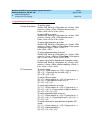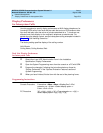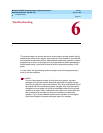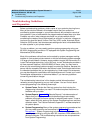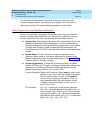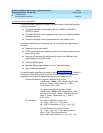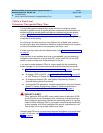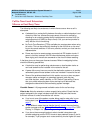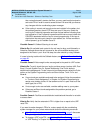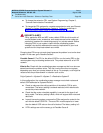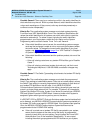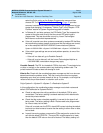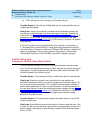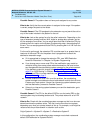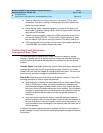
MERLIN LEGEND Communications System Release 6.1
Network Reference
555-661-150
Issue 1
August 1998
Troubleshooting
Page 6-6Call to Non-Local Extension: Silence or Fast Busy Tone
6
Call to Non-Local Extension:
Silence or Fast Busy Tone 6
The following are likely circumstances in which silence occurs when a call is
attempted:
■ A selected tie or analog facility between the caller or called extension is out
of service. After four consecutive occurrences, this can be verified by
checking for an outgoing analog facility hardware error such as 8410 (no
outgoing seizure) or 840B (no loop current). Call your service provider to
verify that the line is functioning.
■ No Touch-Tone Receivers (TTRs) available at a remote system when using
tie trunks. This can be verified by checking for the 0c03 error on the error
log on the remote switches. If this error persists, contact your local service
representative.
■ Power was lost at a remote system connected via PRI tandem trunks. If
power is lost then restored, the PRI channels become active and cause
false ringing until the calls are answered or the circuit finishes resetting.
A fast busy tone can have one of several causes. Before investigating further,
check the following possibilities:
■ A technician may be performing maintenance on local tandem trunks or
non-local tandem trunks included in the routes for the call.
■ A power failure may have occurred at the destination system or at another
networked system whose tandem trunks are included in routes for the call.
■ Some of the problems described in this section can occur when a system
manager makes a change in a networked system’s local dial plan,
non-local dial plan, switch identifier, or DS1 Switch Type setting. Ensure
that your private network system forms are kept up to date and that
changes are cleared with the coordinating system manager.
Possible Cause 1: All programmed available routes for the call are busy.
What to do: Note the extension number range(s) being called. Check that the
pattern assigned to the range includes routes that include pools that have a
sufficient number of trunks to handle the call volume.
■ If you’re not sure of the pattern number being used to route calls in your
local system, see “Reviewing the Non-Local Dial Plan and Routing” on
page 3.
■ To add different routes that can handle the call, consult the coordinating
system manager and see “Uniform Dial Plan Routing” on page 25
or “UDP
Routing” in Chapter 4 of
System Programming.
■ If you do not have enough tandem trunks to handle intersystem calls,
consider assigning pools of PSTN trunks to less preferred routes (3 and 4,
for example). If you program such routes and they involve higher toll costs



